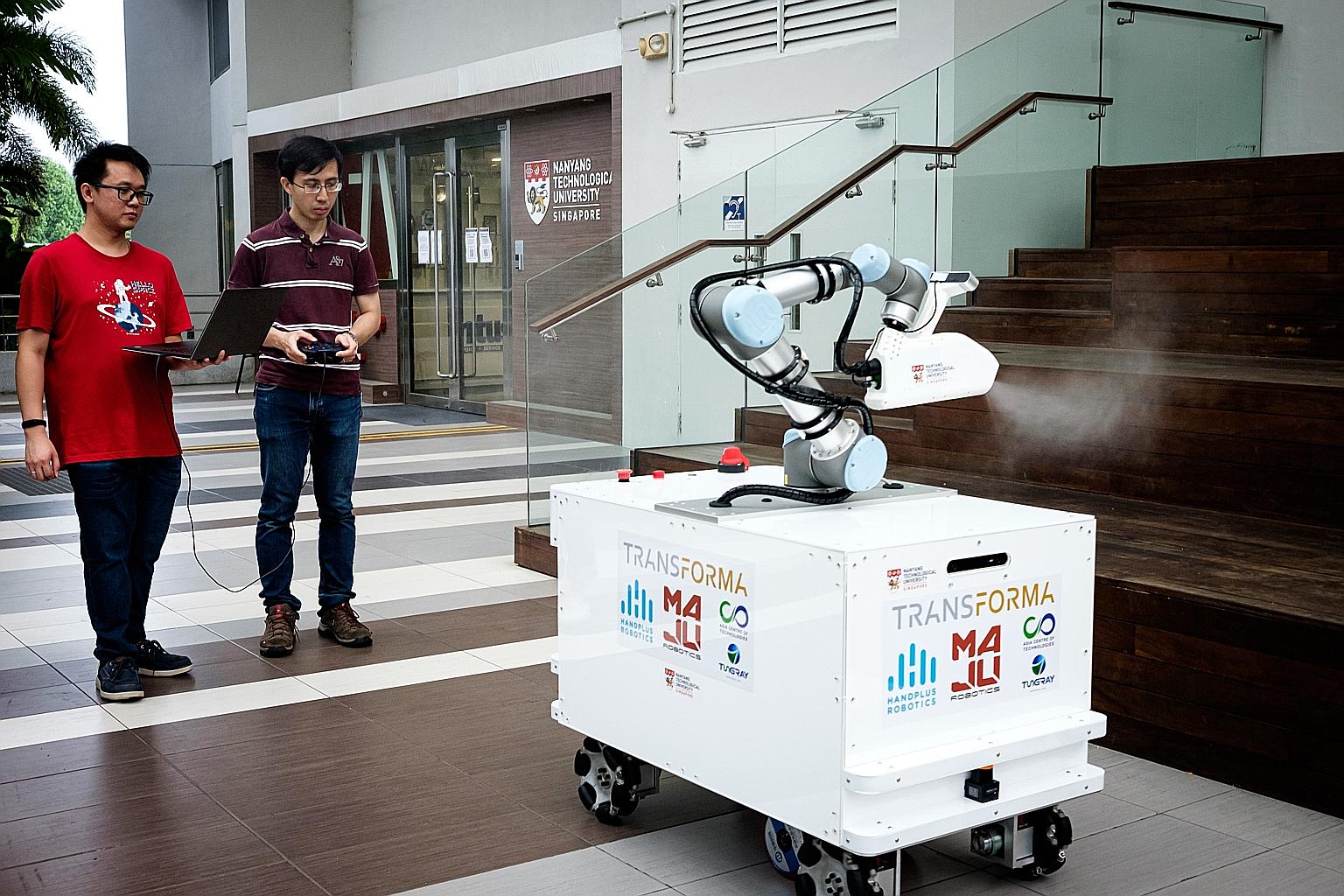Coronavirus: Robots make light work of surface disinfection
Two models to soon be used in public places as S'pore gears up to battle Covid-19 for long haul
Sign up now: Get ST's newsletters delivered to your inbox

Mr Chong Zheng Hao (left) and Dr Quek Zhan Fan with the eXtreme Disinfection roBot, or XDBot.
PHOTO: NTU
Follow topic:
The cleaning of surfaces will be enhanced with technology as Singapore prepares to deal with Covid-19 for the long haul.
Disinfection robots using electrostatically charged sprays and ultraviolet-C (UV-C) light will soon be rolled out in public places, helping to lighten the load of cleaners and also to make disinfection more thorough and sustainable.
The semi-autonomous robot, which can disinfect large surfaces quickly, is called the eXtreme Disinfection roBot, or XDBot, and was designed and built in six weeks by a team of eight from Nanyang Technological University (NTU).
Professor Chen I-Ming, who leads the team, is also the founder of start-ups Transforma Robotics and Hand Plus Robotics.
The idea was mooted some time in February, after Singapore moved up its response to the coronavirus outbreak to code orange. The robot can be wirelessly controlled via a laptop or tablet and uses electrostatically charged sprays, instead of conventional pressure sprays.
Conventional sprays are non-directional, spraying in all directions. Electrostatically charged sprays will go to surfaces the way opposite poles of magnets are attracted to each other, allowing them to wrap around and enclose the whole surface of the object - especially in hidden spots.
This enables even distribution of the disinfectant on the surface. The nozzle size and pressure can also be adjusted.
The XDBot has a robotic arm with six degrees of freedom, which means it can mimic human movement to reach awkward spots, such as under tables and beds, as well as doorknobs, tabletops and light switches.
The researchers are also planning to have public trials for the robot once the circuit breaker period ends and they can return to NTU to work on it.
"The need for disinfection and cleaning of surfaces will extend even after the virus has peaked and numbers have gone down," Prof Chen told The Straits Times.
"With so many foreign workers involved in the cleaning sector, we hope this will help to alleviate the manpower crunch, protect front-line cleaning staff who come into contact with such surfaces and make their job easier."

Manual cleaning might also introduce the possibility of cross-contamination and is subject to human error, where cleaners may miss a spot, Prof Chen added.
Meanwhile, local robotics technology firm PBA Group has designed a disinfecting robot that uses ultraviolet-C (UV-C) light. This will soon be rolled out in public areas.
Called the Sunburst UV Disinfecting Mobile Robot (Sunburst UV Bot), it emits powerful UV-C rays that can decontaminate the environment by tearing apart strands of virus DNA. It moves around autonomously and is guided by light detection and ranging sensors. When power is low, the robot is also able to self-navigate to its charging station. It is able to operate for around 2.5 hours on a charge.
UV-C light kills around 99 per cent of bacteria and has been clinically proven to eliminate viruses.
With the droplets of viruses being so fine they can be suspended and remain airborne for several hours, disinfecting surfaces especially via methods like manually cleaning and spraying disinfectant solutions will pale in comparison to UV-C light disinfecting.
The robot has been proven to be able to kill other viruses very similar to the coronavirus, such as those behind the Middle East respiratory syndrome and the severe acute respiratory syndrome.
The robot will move to a designated checkpoint in a room, stop and shine UV-C light for a period - around 10 to 20 minutes depending on the size of the area - before moving on to the next checkpoint. It is around 1.7m to 2m tall with the UV module attached to it.
This robot is part of PBA Group's fleet of smart autonomous mobile robots, which use data from cameras, built-in sensors and software to detect, navigate and adapt to the environment. This data is collected from the hundreds of robots already deployed in the field since 1987.
"This tech initiative is one of the ways PBA Group helps Singapore to battle the pandemic, and all part of our broader effort to battle Covid-19 as we seek to continue to leverage our technology and resources for good," said the group's chief executive Derrick Yap.

